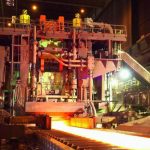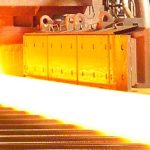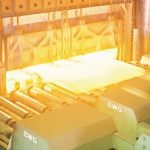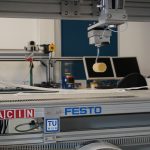
Modeling and control of a four-high heavy plate rolling mill
In heavy plate rolling, the heated plate is plastically deformed between two work rolls. Various measures avoid or minimize the deflection of the work rolls and thus the lateral non-uniformity of the product thickness profile. A mathematical deflection model yields the plate exit thickness, which cannot be directly measured. A model-based feedforward strategy compensates the disturbances observed in the previous rolling pass. Read more →

Lateral guiding and shape control in heavy plate rolling
In the rolling process of heavy plates, contour errors (deviations from the desired straight contour in the top view) and a lateral off-center position of the plate in the rolling mill may occur. Tailored continuum-mechanics models explain the reasons for these errors. The errors are monitored in real time by a camera-based measurement system. Model-based control strategies ensure that contour errors are avoided and that the plate moves straight through the rolling mill. Read more →

Modeling, observer design, and control of continuous slab reheating furnaces
In the steel industry, products are reheated in continuous reheating furnaces as a preparation for rolling. The reheating process requires large amounts of energy and incurs high costs. The temperature during this process is decisive for the product quality. Based on mathematical process models, state observers and controllers for the non-measureable product temperature are developed. The nonlinear model-predictive multi-input multi-output controller ensures a high accuracy, minimized energy consumption, and reduced CO2-emissions of the reheating process. Read more →

Thermal model and optimal time scheduling of hot rolling
In a heavy-plate rolling mill, hot slabs are rolled out. The plate temperature depends significantly on the process times and it directly influences the product quality. Mathematical models are used for better prediction and control of the product temperature. These models are also useful for an optimization of the processing times. Read more →

Optimization of process times and product sequences in a hot-rolling mill with batch-type reheating furnaces
In semiconductor manufacturing, sputtering processes require targets made of pure metals or alloys. The hot-rolling plant considered in this project produces such target of sintered refractory metal slabs. The goals of this project are to minimize the reheating times and to optimize the product sequence and the processing times for maximum product throughput. Read more →

Automated Handling of Highly Deformable Materials
In this project, a prototype of a handling system is set up and the potential of modern model-based control to handle limp materials is examined. The concepts are applicable to many other issues, such as the automated lamination of large vinyl sheets, textile handling, etc. Read more →